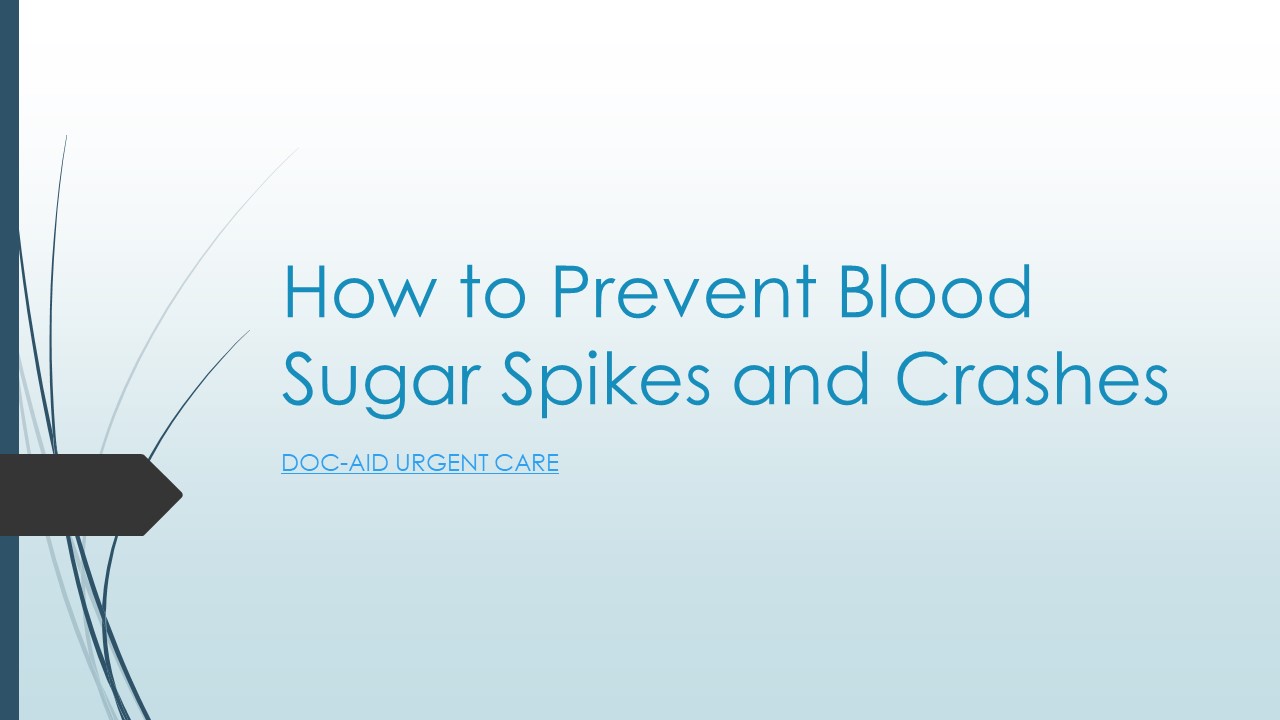How to Prevent Blood Sugar Spikes and Crashes - PowerPoint PPT Presentation
Title:
How to Prevent Blood Sugar Spikes and Crashes
Description:
Learn how to prevent blood sugar spikes and crashes. Reduce your risk of type 2 diabetes and other health problems by keeping your blood sugar levels stable – PowerPoint PPT presentation
Number of Views:1
Title: How to Prevent Blood Sugar Spikes and Crashes
1
How to Prevent Blood Sugar Spikes and Crashes
- DOC-AID URGENT CARE
2
- Maintaining a healthy blood sugar level can be
difficult for those familiar with the pattern of
blood sugar spikes and crashes that send them on
an energy roller coaster throughout the day.
While all of us experience some fluctuation in
blood sugar levels after meals and in between
meals, a sudden increase or decrease in blood
sugar can ruin your day, make you feel tired, and
make you crave carbs, making it difficult to lose
weight or keep your body weight in check. - Snacking is the worst way to deal with a blood
sugar crash because it triggers a second surge.
Your body releases insulin, which tells your
cells to use the extra energy, or your body will
store extra fuel as fat.
3
What Makes Blood Sugar Levels Go Up Quickly?
- All foods contribute to increased blood sugar
levels as a natural part of the digestive
process. So, high blood sugar levels after a meal
are normal. - Blood sugar levels vary between people, and these
changes are known as blood sugar spikes. Blood
sugar spikes occur when there is a rapid increase
in blood sugar levels after consuming
high-carbohydrate foods. When we eat sugar-rich
foods such as donuts, chips, or white bread, our
bodies break these simple carbohydrates into
sugar. This sugar circulates in our bloodstream
as glucose. - As glucose enters your bloodstream, your blood
sugar levels rise. This causes your body to
release insulin, a hormone that allows glucose to
leave your blood and enter your cells, where it
can be used for energy or stored to be used
later. - According to a study, blood sugar fluctuation
happens in everyone, even those who dont have
diabetes or think theyre healthy and active.
According to the Centers for Disease Control and
Prevention (CDC), over 96 million adults in the
United States live with prediabetes, and over 80
percent dont know they have it.
4
What Causes Low Blood Sugar?
- Low blood sugar, also known as hypoglycemia, can
be caused by various things, such as skipping
meals, taking too many insulin injections, taking
other diabetes medications, exercising more than
usual, or drinking alcohol. A blood glucose level
of less than 70 milligrams per deciliter (mg/dL)
is low. - The sign of low blood sugar vary from person to
person, but common ones include - shaking or trembling
- feeling hot or sweaty
- feeling nervous or anxious
- feeling irritable or confused
- feeling dizzy
- feeling hungry
5
What Are the Best Ways to Lower My Blood Sugar?
- Consult a doctor to determine the best course of
action to maintain blood glucose levels in the
desired range. Your doctor may suggest the
following - Be more active. Working out also helps regulate
your blood sugar levels. One thing to note is
that if you have ketones in your urine, you
should not exercise, as this can cause your blood
sugar to rise further. - Take medicine as instructed. If you have high
blood sugar regularly, your doctor may adjust the
dose or timing of your medication. - Follow your diabetes meal plan. Talk to your
doctor or nutritionist if you need help staying
on track with your diet. - Monitor your blood sugar more frequently if you
are ill or worried about elevated or decreased
blood sugar levels. - Consult with your physician to determine the
appropriate insulin dosage and the type of
insulin to be administered.
6
What Other Lifestyle Changes Can I Make to Help
Control My Blood Sugar?
- Eating a balanced diet with lots of fruits and
veggies, maintaining a healthy body weight, and
engaging in regular physical activity are all
ways to improve your health. Other tips include - Monitoring your blood sugar levels and seeing
what causes them to rise or decrease. - Eating at regular times and not skipping meals is
essential. - Choose foods low in calories, saturated fat,
trans-fats, sugars, and salt. - Track what you eat and drink and how much
exercise you do. - Drink water rather than juice or soda.
- Limit alcoholic beverages.
- For sweet treats, choose fruit.
- Control how much you eat by using the plate
method. For example, Fill half of your plate with
a non-starchy vegetable, a quarter with a lean
protein, and half with a grain or starch food.
7
Getting Help With Your Blood Sugar at the Urgent
Care Center
- Urgent care clinics can be an excellent option
for managing blood sugar levels, especially if
you are experiencing high blood sugar
(hyperglycemia) or low blood sugar
(hypoglycemia). Urgent care clinics typically
open longer than primary care offices and can
often provide same-day care. - You should go to an urgent care center to manage
your blood sugar if you are experiencing any of
the following symptoms - High Blood Sugar increased thirst, frequent
urination, extreme hunger, blurred vision,
fatigue, headache, abdominal pain, nausea and
vomiting, or rapid breathing. - Low Blood Sugar sweating, tremors, anxiety,
dizziness, lightheadedness, hunger, confusion, or
seizures.































